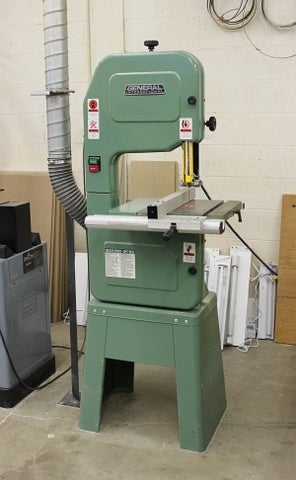Description and uses
The band saw is very versatile cutting device; it can make both straight and curved cuts. Blades come in various widths, allowing the saw to cut fairly small arcs. The size of the workpiece is limited by the distance between the body of the saw and the saw blade. Our 14 inch band saw is used for most application, but we also have a 22 inch band saw that allows larger materials to be cut.
Adjust upper guide assembly so it is 1/4'' above the work. Allow the saw to reach full speed before using. Keep hands at least 2'' away from the blade when the saw is running. Make turns carefully and do not radii so small that the blade is twisted. Stop the machine before backing out of a long curved cut. The 14 inch saw comes with an adjustable fence and a mitre gage. These features make it especially useful for making accurate cuts on small pieces that would too unmanageable and dangerous to cut on saws with rigid circular blades.
Further considerations
- If you hear a clicking noise, turn off the machine at once. This indicates a crack in the blade.
- Verify location of on off switch and/or emergency power disconnect.
- If used, check to ensure the fence is set properly and tight.
- Ensure that the table is clear of materials, tools, an debris.
Band saw hazards
The saw blade is easy to twist and crack. This machine requires you to listen constantly.
Shut it down if its behaviour deviates.
"Dust Hazard" are produced by many woods and materials when their dust is airborne and inhaled, providing a toxicity and cancer risk. Some woods are more toxic than others, such as cedar, pressure treated woods and teak. The glues associated with ply woods, particleboard and mdf contain formaldehyde and have been shown to be toxic.
Foreign objects in the wood itself pose a threat, such as nails, screws, stones, wire etc. Not only can they induce potential injury, but they do damage to the machine surface, fence, and blade.
Tips
Make relief cuts in convex curves. Cut straight lines from edge of workpiece to cutting line, so that as you cut the curve, excess material will be separated from workpiece in incremental pieces, preventing the blade from being trapped.
It is possible to nibble out notches and dadoes with a band saw. When performing one of these operations it is important to keep the heels of your hands firmly on the bed of the saw and creep the material into blade by extending your fingers. This technique prevents you from pushing your hand into the path of the saw. Ask the woodshop technician for a demonstration.
Cautions
- Eye protection is mandatory
- Ear protection is required for prolonged use.
- A dust mask is recommended for plywood and particleboard and required for MDF and certain toxic woods.
- Only operators trained in the safe operation of a band saw are allowed to use the saw.
- Never start the machine with the blade touching the workpiece.
